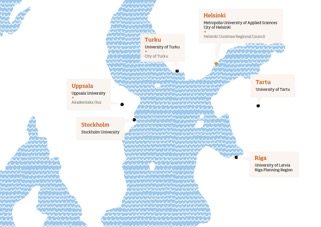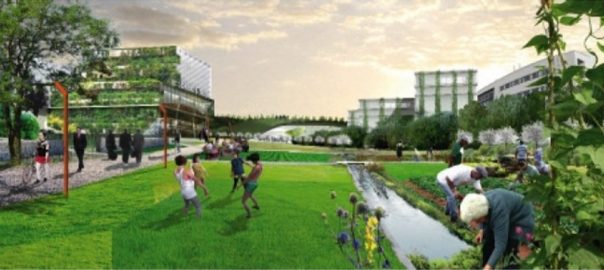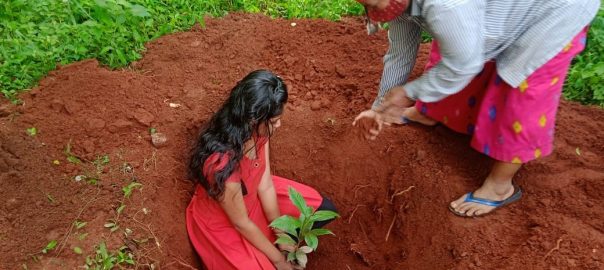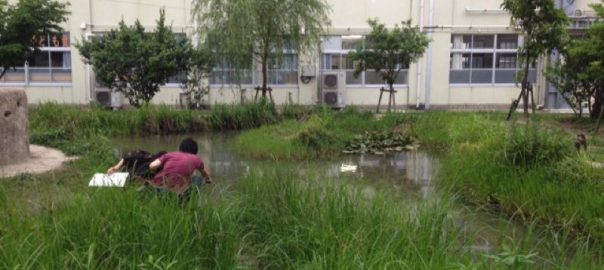Jane Jacobs critiqued modernist city planning in the now classic book The Death and Life of Great American Cities (1961). This book is now inspiring an urban renaissance. Jacobs proposed that a city must be understood as a system of organized complexity—in other words, as an ecosystem—and that any intervention in the urban fabric with a lack of such understanding is bound to result in unexpected surprises. Trained in zoology, Jacobs viewed the city much like a coral reef, where co-evolutionary dynamics between the coral organisms (the people) and the coral reef (the built environment) result in the emergence of a socio-spatial logic that can support various kind of functions and opportunities for people.
First line of urban scholarship based on ecological thought
Blueprint planning based on ideals such as Le Corbusier’s “The Shining City,” or Sir Ebenezer Howard’s “The Garden City,” Jacobs argued, is likely to fail since it lacks the critical understanding of the city as a complex socio-spatial system. Spatial morphology thinking (Hillier and Hanson, 1984) provided a precision and an analytical depth to the insights of Jane Jacobs. Density, accessibility and diversity are outlined as the main features of spatial capital for people in cities (Marcus, 2010), which are akin to insights in ecosystem ecology, where species diversity, species abundance and ecological connectivity are critical features.
Social-ecological urbanism is a scientific upgrading of landscape urbanism concepts.
During that historically transformative era, the first line of ecological urban thinking emerged; it focused on human-technology relations in the search for an understanding of the city as an organism, or as a ‘living artifice,’ that would enable humanity to take off into a bright, humanistic future. Jane Jacobs based her thinking on this first line of thought, but enhanced it considerably by incorporating a much more advanced understanding of complexity. She also departed from an inductive understanding of a spatial scale in cites, choosing a scale that instead makes sense based on how people perceive their daily lives.
2016 is the 100th anniversary of Jane Jacob’s birth, yet her work continues to hold promise for finding solutions to many current sustainability challenges. For instance, it provides cognitive tools for analyzing the spatial logic that lies behind the production of socioeconomic inequalities in cities (Legeby, 2013), as well as design solutions to reduce the number of car trips, to increase walkability and to enhance energy efficiency in cities.
Jacobs’ work does not, however, adequately address complex social-ecological systems relations of urban sustainability. Many global environmental challenges have emerged since Jane Jacobs wrote her classic book. It is safe to argue that most urban populations, at least in the Global North, are more cognitively distant from their life support systems—such as agriculture—than they were in 1961. Urbanization is now in a second wave of space–time compression driven by the Internet, jet travel, and the global economy (Harvey, 1990). The accelerating pace at which urban life proceeds and the decreasing importance of geographic barriers and distances are qualitatively different in terms of their intensity and scope compared to the 1960s (Sassen, 1991). Space–time compression is an outcome of a surplus of fossil fuel energy of diminishing returns (Tainter, 2011), which enables cities to sequester natural resources and ecosystem services from the farthest reaches of the planet (Deutsch et al., 2013; Seto et al., 2012).
Urban thought’s second line
A second line of thought that is also based on systems ecology emerged in the 1990s, with the concepts of ecological footprints (Rees 1992), extended versions of urban metabolism (Newman, 1999) and urban ecosystem services (Bolund and Hunhammar 1998). This line offers an important alternative perspective, since it assumes that humans are part of an intricate and complex web of life that goes far beyond the borders of any city. In just a few decades, this social-ecological lens has been used to argue that cities must offer better stewardship of ecosystems inside and outside their borders (Krasny and Tidball 2012; Enqvist et al., 2014) and must improve the capacity to cognitively reconnect city inhabitants with the biosphere (Andersson et al., 2014). Scholars of this kind of thinking also came to argue for the missing role that urban ecosystems, such as urban agricultures or wetlands, hold as technologies for building urban resilience towards extreme external disturbances (McPhearson et al., 2015; Barthel et al., 2015; Lewis 2015). The world’s ecosystems are gradually being eroded, with a subsequent loss of both ecosystem services and social-ecological resilience (Berkes et al. 2003), not only due to rapid urbanization per se, but also due to other global drivers such as climate change, population growth and tele-connected consumption behaviors (Seto et al., 2012), which ultimately will be shaped by environmental attitudes among city people (Grimm et al., 2008).
In 1961, the plethora of benefits that ecosystems in cities provided for human well-being in cities were simply not known (McPhearson et al., 2015; Haase et al., 2014). While Jacobs’ thinking is based on ecosystem logic, it does not see the benefits humans obtain by sensory interaction with other species and with diverse ecosystems. She viewed urban life to be an essentialist reality separated from such social-ecological relations, and from their role in shaping learning, meaning-making and cognitive dimensions in humans (Bendt et al., 2013; Colding and Barthel, 2013). For instance, Jacobs saw urban form as a cognitive artifact, where physical space also interacts with the way we think and feel, but she did not adequately address the role that nature environments in cities play in the development of attitudes, health and cognitive performance (Hartig et al., 2014; Bratman et al., 2015). For instance, Giusti et al. (2014) showed that pre-school children that experience nature environments in their daily routines develop significantly stronger environmental attitudes than those that do not. Nevertheless the socio-spatial dimensions of the work of Jane Jacobs cannot be underestimated in urban scholarship.
Social-ecological urbanism: aligning the two lines of thought
There is a need to align these two lines of thinking, because even if both build on our understanding of complex ecosystems, they are actually producing different urban systemic pictures, and they solve different kinds of challenges in urban sustainability.
Few, if any, attempts have been made to link urban social-ecological systems thinking with Jane Jacobs’ understanding of the city as an ecosystem. But in 2009, these two lines of thought met during the creation of a vision for a new campus area in Stockholm. This campus is called Albano.
The Albano site is situated just north of the inner city of Stockholm on formerly industrial land and has long been the subject of conflict and controversy. In 2009, the old industrial area was used primarily for temporary parking and as a storage area. However, this strategic location right at the edge of the dense inner city fabric, in between two of the major urban development areas and at the intersection of the three major universities in Stockholm, made it interesting from an urban morphology perspective. The Albano site is also located within the limits of the world’s first national urban park, Stockholm National City Park, protected by law since 1995. This double strategic perspective makes the site not only the subject of extraordinary development potential, but also a strategic link in Stockholm’s landscape ecology. This urban park is protected as a national interest with high levels of biodiversity and cultural value. The park is huge; the area is 27 square kilometers, including vast and diverse areas of meadows, forests, lakes and streams. It is also associated with a motivated network of civic associations that played a pivotal role in obtaining the protective laws for the park (Barthel et al., 2005; Ernstson et al. 2008).
The design work of this campus area came about in collaboration between researchers at the Beijer Institute of Ecological Economics, the Stockholm Resilience Centre, the Royal School of Architecture in Stockholm, and with practicing architects (Barthel et al., 2013). Civil society organizations and other stakeholders took part in the participatory design processes as well. In 2010, colleagues and I presented an alternative vision for the site to the city planning office, to local politicians, and to the university leadership. The vision won support from all those actors. It was carried all the way into a detailed plan, which was co-designed with the city architect in Stockholm. Further investigations, reports and alterations were undertaken until 2012, when the City Council of Stockholm approved this detailed plan. The construction work of Albano started in November 2015.
It includes 100,000 square meters of buildings, including apartments for students and researchers. It attempts to support ecological connectivity in the wider landscape, as well as social and spatial accessibility to the street network of the urban fabric. Our designs accommodated local conditions for energy production and approached the greening of buildings with vegetation selected in relation to the surrounding landscape. We designed new habitats to support such landscape ecological processes of species migration, pollination and seed-dispersal. The design also involved development of institutional designs related to urban green commons (Colding and Barthel 2013), by which local civil society organizations, students and scholars can become managers and stewards of habitats and green spaces in the area (from wetland ponds to allotment gardens).
The project is expected to make a positive contribution towards a low-carbon economy. Designs focus on social-ecological resilience (such as adaptations to climate change) and mitigation measures to reduce carbon consumption for Stockholm’s Albano Campus. For instance, the integrated campus development plans will include better mobility solutions between the city and the campus and within campus (walking, bicycling and public transport), and also includes novel energy solutions that will be continuously updated parallel to technological innovations. The climate adaptation designs include carbon absorbing design elements (nature-based solutions) that simultaneously support the generation of local ecosystem services.

In the design process, one unexpected effect was a theoretical merging of social-ecological urban systems thinking with urban morphology thinking inspired by Jane Jacobs, which gave birth to what we now call Social-Ecological Urbanism (Barthel et al. 2013; Marcus and Colding 2014).
The combination of these two thought lines provides a cognitive step towards the city’s aim to generate an ecosystem-based urban transformation, where cities are seen as embedded in the biosphere, and where social-ecological relations on the micro-scale are considered alongside spatial features for combating social segregation and for creating walkability and safety. From a discourse point of view, Social-Ecological Urbanism can be seen as a second generation following the dominance of the smart growth paradigm, since it deals not only with designs for mitigation of carbon emissions, but also with adaptation measures to enhance adaptive capacities in relation to emerging surprises. It does so by searching for synergies between ecological and sociospatial systems, where resilience is used as the systems’ capacity to absorb shocks, utilize them, reorganize and continue to develop without losing fundamental functions. In this sense, social-ecological urbanism can be viewed as a scientific upgrading of landscape urbanism concepts.
Insights about the design process behind this work include the importance of: (1) respectful interdisciplinary working conditions, including exchanging knowledge and terminology in productive ways; (2) translation of scientific knowledge into physical, institutional and discursive artifacts that both ‘protect’ and communicate the ideas; and (3) respect for how to navigate within the power landscape in which urban planning and design is embedded.
This design process will be used as an example of ‘best practices’ in the building of a science-practice network in the Baltic region that can lay a foundation platform for learning, innovation and friendship. Albano acts as a foundation for the EU-project called LIVE BALTIC CAMPUS – Campus Areas as Labs for Participative Urban Design.

Other collaborations that have emerged directly from this project include several collaborations with non-academic actors within the Stockholm region, as well as a partnership with Urban Mistra Futures at Chalmers in Gothenburg. We hope that aligning these two different lines of thought under the framework of Social-Ecological Urbanism brings novel innovations with interesting repercussions for the international debate on sustainable urban development. We also hope the Albano Campus, as a persistent artifact example, may inspire architects to join the broader quest of sustaining the web of life of which we are all a part.
Stephan Barthel
Stockholm
Literature
Andersson, E., Barthel, S., Borgström, S., et al. (2014). Reconnecting Cities to the Biosphere: Stewardship of Green Infrastructure and Urban Ecosystem Services. AMBIO. 43: 445-453.
Barthel, S. Parker, J. Ernstson, H. (2015). Food and Green Space in Cities: A Resilience Lens on Gardens and Urban Environmental Movements. Urban Studies. 52(7), 1321-1338.
Barthel, S. and Isendahl, C. (2013). Urban Gardens, Agricultures and Waters: Sources of Resilience for Long-Term Food Security in Cities. Ecological Economics. 86, 224-234.
Barthel, S., Colding, J., Ernstson, H., Erixon, H., Grahn, S., Kärsten, C., Marcus, L., Torsvall, J. (2013). Principles of Social-Ecological Urbanism – Case Study: Albano Campus, Stockholm. TRITA-ARK Forskningspublikationer 2013:3, Stockholm. ISBN 978-91-7501-878-2.
Barthel S., Colding J., Elmqvist T., Folke C. (2005). History and Local Management of a Biodiversity-rich, Urban, Cultural Landscape. Ecology and Society. 105(2), 10.
Bendt, P. Barthel, S. and Colding, J. (2013). Civic greening and environmental learning in public-access community gardens in Berlin. Landscape and Urban Planning. 109: 18– 30.
Berkes, F., J. Colding, and C. Folke. 2003. Navigating social-ecological systems: Building resilience for complexity and change. Cambridge University Press, Cambridge, UK.
Bolund, P., and S. Hunhammar. (1999). Ecosystem services in urban areas. Ecological Economics. 29:293–302.
Bratman, G. N., et al. (2015). The benefits of nature experience: Improved affect and cognition. Landscape and Urban Planning. 138: 41–50
Clements, F.E. (1916). Plant succession: an analysis of the development of vegetation. Carnegie Institution of Washington Publication No. 242. Carnegie Institution of Washington, Washington, DC.
Colding, J. and Barthel, S. (2013). The potential of ‘Urban Green Commons’ in the resilience building of cities. Ecological Economics. 86: 156–166.
Deutsch, L., Dyball, R., Steffen, W. (2013). Feeding cities: food security and ecosystem support in an urbanizing world, in: Elmqvist, T., et al. (Eds.), Urbanization, Biodiversity and Ecosystem Services: Challenges and Opportunities: A Global Assessment. Springer, Dordrecht.
Enqvist, J., Tengö, M., Bodin, Ö. (2014). Citizen networks in the Garden City: Protecting urban ecosystems in rapid urbanization. Landscape and Urban Planning. 130, 24-35.
Ernstson, H., S. Sörlin, and T. Elmqvist. (2008). Social movements and ecosystem services—The role of social network structure in protecting and managing urban green areas in Stockholm. Ecology and Society. 13: 39.
Giusti, M., Barthel, S., Marcus, L. (2014). Nature Routines and Affinity with the Biosphere: A Case Study of Preschool Children in Stockholm. Children, Youth and Environments. 24(3): 16-42.
Grimm, N. B., Faeth, S. H., Golubiewski, N. E., et al. (2008). Global change and the ecology of cities. Science. 319, 756–760.
Haase, D., Frantzekaki, N., Elmqvist, T. (2014). Ecosystem Services in urban landscapes: practical applications and governance implications. AMBIO. 43, 407-412.
Hartig, T., et al. (2014). Nature and Health. Annu. Rev. Public Health. 35: 207–28.
Harvey, D. (1990). The Condition of Postmodernity. Blackwell, Malden.
Hillier, B., and J. Hanson. (1984). The Social Logic of Space, Cambridge University Press, Cambridge, UK.
Jacobs, J. (1961). The Death and Life of Great American Cities. Vintage Books, London.
Krasny, M. E. & K. G. Tidball. (2012). Civic ecology: a pathway for earth stewardship in cities. Frontiers in Ecology and the Environment. 10(5): 267-273.
Legeby, A. (2013). Urban Segregation And Urban Form: From residential segregation to segregation in public space. Ph.D. thesis. KTH, Stockholm.
Lewis, J. (2015). Deltaic Dilemmas-Ecologies of Infrastructure in New Orleans. PhD-thesis Stockholm University, Stockholm Resilience Centre. ISBN 978-91-7649-239-0. http://urn.kb.se/resolve?urn=urn:nbn:se:su:diva-119390.
McPhearson, T., Andersson, E., Elmqvist, T., Franzeskaki, N. (2015). Resilience of and through urban ecosystem services. Ecosystem Services. 12, 152-156.
Marcus, L. (2010). Spatial Capital: a proposal for an extension of space syntax into a more general urban morphology. Journal of Space Syntax. 1 (1).
Marcus, L. & Colding, J. (2014). Towards an integrated theory of spatial morphology and resilient urban systems. Ecology and Society. 19: 55.
Newman, P. W. G. (1999). Sustainability and Cities: Extending the metabolism model. Landscape and Urban Planning. 4(1), 219-226.
Rees, E., W. (1992). Ecological Footprints and appropriated Carrying Capacity: What Urban Economies Leaves out. Environment and Urbanization. 4(2), 121-140
Sassen, S. (1991). The Global City. Princeton University Press, New York.
Seto, K. C., Reenberg, A., Boone, C. G., et al. (2012). Urban land teleconnections and sustainability. Proceedings of the National Academy of Sciences. 109, 7687-7692.
Tainter, J. (2011). Energy, complexity, and sustainability: a historical perspective. Environmental Innovation and Societal Transitions. 1, 89–95.
Wirth, L. (1938). Urbanism as a way of life. The American Journal of Sociology. 44, 1–24.







Leave a Reply